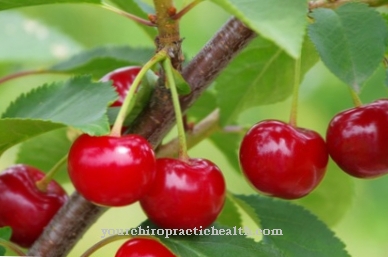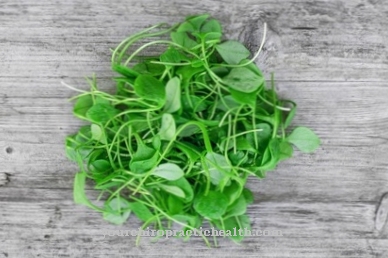The radish comes from the cruciferous family and is therefore closely related to the radish family. The red tuber of radishes has a pungent aroma due to the mustard oil it contains and is eaten raw, in salads or as a topping on bread.
What you should know about radishes

From March the radishes are sown; the seed should not be placed deeper than one centimeter in the soil. The individual plants need sufficient distance from one another; A distance of about 15 centimeters has proven itself here.
The soil layer must be at least 15 centimeters deep so that the roots of the plant can develop sufficiently. The radish can also thrive despite the rather fresh temperatures from ten degrees. Too much sun is actually harmful to the growth of the plant. They germinate after just a week, provided the soil is supplied with sufficient moisture and nutrients. If this is not the case, only underdeveloped and not very tasty tubers form. Basically, the radish, whose name is derived from the Latin radix (root), is an undemanding plant that does not need a special soil profile in order to grow.
Adequate watering is still mandatory. About a month after sowing, the radish tubers can already be harvested, so that the radishes are one of the first regionally available vegetable varieties of the year with their harvest time from April in Germany. The bed of radishes can be tilled until September by sowing a few new plants after the harvest. Plants such as chard, beans or spinach are recommended for neighbors to grow radishes. Only with cucumbers does the radish plant not harmonize optimally: Since both plants use up very similar nutrients and a lot of moisture when growing, they prevent each other from developing optimally. If the radish is not harvested in time after it is ripe about four to six weeks after sowing, this becomes noticeable in the unpleasant taste of the overripe tubers.
85 percent of the German radish harvest comes from the state of Rhineland-Palatinate. Radishes have been on the menu in Europe since the 16th century, and this development began in what is now France. The plant probably originally came from China. The best known is the wine-red variety, which was grown as an ornamental plant in China centuries ago. In addition to the red radish, there are also numerous other varieties that you can buy from time to time on the market: There are also yellow or white variants of the spicy vegetables.
Importance to health
In the case of colds, the sharp, essential oils of radish help the mucous membranes to regenerate. Cough and hoarseness is relieved by consumption.
Their antibacterial effect can even prevent flu-like infections and also kill other germs that are in the digestive tract. Since radishes stimulate the activity of the liver and bile, they can help a sluggish digestion. In addition, the consumption of radishes helps to lower the cholesterol level. The mustard oils contained in radishes are also suspected of preventing cardiovascular diseases. The smaller a radish, the higher the concentration of mustard oil it contains, and the more health-promoting substances you take in when you eat it. The concentration of mustard oils is highest in radishes grown outdoors.
Mustard oils have a dehydrating effect and thus lower blood pressure; at the same time, the mustard oils bind fats so that they are excreted undigested. If you want to lose weight, the radish is not only a low-calorie snack, but it also absorbs important substances that help you lose weight.
Ingredients & nutritional values
Radishes are very low in calories: 100 grams contain just 14 calories. Most of the radish consists of water, but the tuber also contains fiber, which is why it contributes to satiety.
The product contains just two grams of carbohydrates per 100 grams and even less fat. Instead, radishes are rich in calcium, potassium, and phosphorus. Iron and various other vitamins, such as vitamin C, are also rich in radishes. Radish is a source of folic acid for pregnant women.
Intolerances & allergies
A food allergy or even a contact allergy to radishes occurs only in rare cases. Patients who are also allergic to radish often suffer from a radish allergy. Here a complete renouncement of the food is appropriate.
Shopping & kitchen tips
Radishes are available all year round; for this purpose, different varieties are planted in the different seasons, which can thrive despite the respective weather conditions.
Sometimes the cultivation takes place in the greenhouse. Radishes grown outdoors are the best tasting: they have the most intense aroma. Those who rely on organic radishes minimize the risk of ingesting toxic substances such as pesticides when consuming the tubers. The shelf life of radishes is limited; After just a few days, the leaves of the plant begin to wither, and the radishes form dents as they dry out. Consumption should take place before these phenomena; buying tubers that have already aged is not advisable.
The signs of aging in the tuber can be delayed a little after buying them if you wrap the radishes in a damp cloth in the refrigerator or put them in a small bowl with water. This way the vegetables don't dry out and stay fresh longer. The leaves should also be completely removed in the course of storage so that they can no longer withdraw any liquid from the tuber. However, no later than three days after purchase, the radishes have reached the end of their shelf life.
Preparation tips
Radishes can be eaten unprocessed and raw. It is not necessary to peel the tuber; only the tuber should be washed off thoroughly before consumption. A little salt will soften the heat and make radishes more aromatic. Finely sliced, radishes can be placed on a sandwich.
The wine-red tuber is also good in salads: it tastes best here in grated or thinly sliced form with a little vinegar, oil, pepper and salt. However, radishes should never be cooked, as they then lose their taste. They can only cope with a short searing in a wok; But then they complement many Asian dishes well. The leaves of the radish plant can also be eaten as a salad. Another option is to use the radish in a smoothie.













.jpg)

.jpg)
.jpg)











.jpg)